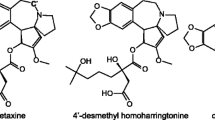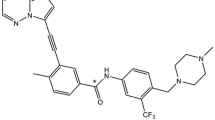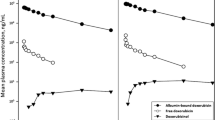Abstract
Purpose: CCNU (lomustine) and other nitrosourea compounds are rapidly metabolized to alkylating moieties, which are active against various malignancies. In humans, CCNU undergoes biotransformation to the geometric isomers of 4′-hydroxyCCNU. The pharmacokinetics of trans- and cis-4′-hydroxyCCNU were determined in five patients with Hodgkin’s or non-Hodgkin’s lymphoma receiving sequential doses of CCNU (15 mg/kg), etoposide (60 mg/kg) and cyclophosphamide (100 mg/kg) prior to autologous bone marrow transplantation. Methods: Plasma concentrations of the isomeric forms of the metabolites were determined by high-performance liquid chromatography. Data were analysed using noncompartmental pharmacokinetic methods. Results: Formation of the trans-isomer predominated over that of the cis-isomer, with an average exposure ratio of 1.4 (range 1.0–2.1). Peak plasma concentrations occurred between 1 and 4.1 h postdosing and averaged 1.56 mg/l for the trans-isomer and 1.10 mg/l for cis isomer. Peak plasma concen- trations and systemic exposures varied approximately six- and ninefold, respectively, reflecting significant interindividual variability in alkylating activity after high doses of CCNU. Plasma half-lives of the metabolites were 3.1 h (range 1.1–4.5 h) for the trans-isomer and 3.5 h (range 1.3–6.4 h) for the cis- isomer, and varied linearly with increasing patient body weight. There was no significant difference in plasma half-lives after high-dose CCNU administration observed in this study and those reported previously after the administration of substantially lower doses of CCNU. Conclusion. Despite linearity in the pharmacokinetics of the isomeric forms of 4′-hydroxyCCNU at high doses, large interindividual variability in exposure to the CCNU metabolites was observed. Potential saturation of metabolic pathways to the isomers at these doses may manifest as toxic symptoms since alkylating moieties formed directly from the parent, CCNU, may be associated with greater toxicity than those formed from the isomeric forms of the 4′-hydroxylated metabolite.
Similar content being viewed by others
Author information
Authors and Affiliations
Additional information
Received: 11 August 1995/Accepted: 2 January 1996
Rights and permissions
About this article
Cite this article
Kastrissios, H., Chao, N. & Blaschke, T. Pharmacokinetics of high-dose oral CCNU in bone marrow transplant patients. Cancer Chemother Pharmacol 38, 425–430 (1996). https://doi.org/10.1007/s002800050506
Issue Date:
DOI: https://doi.org/10.1007/s002800050506




